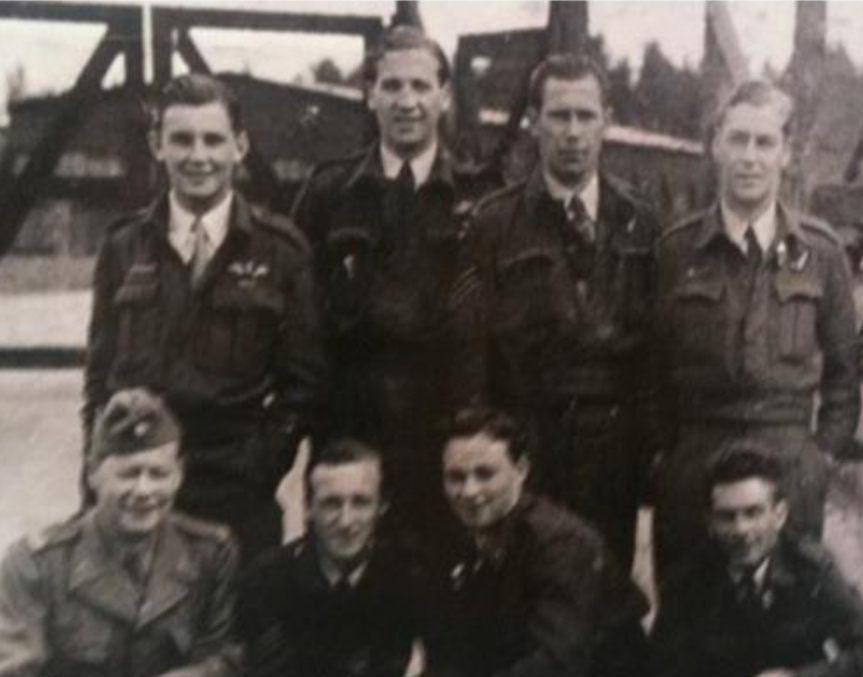 Bomber Command
Bomber Command  |
Aircrew Chronicles
|
Aircrew Losses
|
Nose Art
|
BCATP
|
Lancaster
|
Media
|
Aircrew Chronicles
|
Aircrew Losses
|
Nose Art
|
BCATP
|
Lancaster
|
Media
 Bomber Command
Bomber Command  |
Aircrew Chronicles
|
Aircrew Losses
|
Nose Art
|
BCATP
|
Lancaster
|
Media
|
Aircrew Chronicles
|
Aircrew Losses
|
Nose Art
|
BCATP
|
Lancaster
|
Media
RCAF Halifax HR871 served with No. 405 Pathfinder Squadron. Piloted by F/S John Philips, the Halifax was returning from a raid to Hamburg on Aug. 3 1943 when it was struck by lightning, and lost two engines and vital flight controls. The crew diverted to neutral Sweden and bailed out of the aircraft. They survived and returned to the UK after being interned for several months.
Pilot Sergeant John Alywyn Phillips, Royal Air Force Volunteer Reserve (RAFVR), and his crew - Sergeant H. C. McLean, flight engineer (RCAF); Flight Sergeant G.W. Mainprize, navigator (RCAF); Sergeant. V. A. Knight, bomb aimer (RAFVR); Sergeant R. A. Andrews, wireless operator (RAFVR); Sergeant W. H. King, mid-upper gunner (RCAF); and Sergeant L. D. Kohnke, tail gunner (RCAF) - were the last crew to fly 'LQ-B' for Baker. They were "wheels-up" from Gransden Lodge at 22:58 hours.

During the outbound leg to Hamburg, they encountered a thunderstorm around 21,000 feet (6,400 metres). Ice began to accumulate on the Halifax's control surfaces, making it sluggish and increasingly difficult to control. They would not have stood much of a chance if they had been forced to evade night fighters or flak, and Phillips quickly made the decision to dropping the TI's - target Indicators. Moments later, the forward section of the Halifax was struck by lightning. Both inner engines were knocked out, the radio was useless and several critical instruments stopped functioning. John 'Pee Wee' Phillips recalled, "There was one hell of an explosion! We were blinded by it. Bits of aircraft were flying all over the place." The brilliant flash temporarily blinded Phillips, and he lost control of the lumbering bomber momentarily. With a degree of control and his sight back, Phillips had to weigh the risks of trying to fly his crippled bomber back across the unforgiving North Sea back to England. He made the decision to turn the aircraft in a northerly direction, with the hope of reaching neutral Sweden.
Flying at just under 4,000 feet (1,219 metres) above the Baltic Sea, they made visual contact with a lighthouse and lights from a number of dwellings at Falsterbo. The aircraft passed Ringsjön and Vombsjön. Phillips changed course to a southwesterly heading, which would take the aircraft back out over the Baltic Sea. He trimmed the controls, and then gave the command to bail out. They were in close proximity to Flyinge, Sweden's largest and best-known horse breeding station. One by one, the crew members fell into the dark sky.
The bomber continued flying until it crashed into the Baltic Sea fifteen kilometres off the Swedish coast and sank into twenty metres of brackish (slightly salty) water. Since that time it has been inundated and covered by sand although three engines and small portions of the aircraft remain above the sand on the seafloor.
The crew survived and returned to the UK after being interned for six months. Graham's Mainprize's daughter, Laura Mainprize writes, "Dad landed in a potato patch near a house. Two men came out with a pitchfork but once they understood that he was a Canadian he was treated very well. He was also able to spend Christmas in Sweden with relatives on his mother's side."